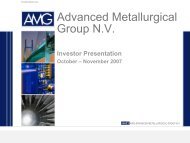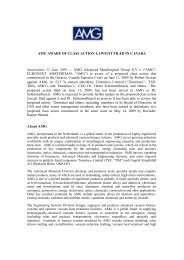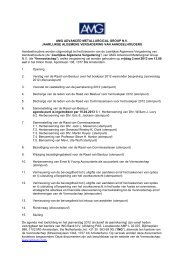C Si Ni Cr V Ti Ta Sc Li Sr Zr Fe Cu Zn Sn B Al Ce U Mn Mo Nb Sb
C Si Ni Cr V Ti Ta Sc Li Sr Zr Fe Cu Zn Sn B Al Ce U Mn Mo Nb Sb
C Si Ni Cr V Ti Ta Sc Li Sr Zr Fe Cu Zn Sn B Al Ce U Mn Mo Nb Sb
You also want an ePaper? Increase the reach of your titles
YUMPU automatically turns print PDFs into web optimized ePapers that Google loves.
It is a strategic objective of AMG to reduce this “downside”<br />
volatility. We are working on this by increasing productivity<br />
to reduce "break-even" prices in all units. We are also<br />
continuing to identify potential “vertical” moves upstream<br />
on the supply lines of our various niche metal markets<br />
and “horizontal” industry consolidation opportunities.<br />
Advanced Materials: The Market for <strong>Cr</strong>itical Metals<br />
On balance, in 2010, our markets have begun to return<br />
to a healthy activity level. The global steel industry is<br />
expected to move into record territory in 2011; and the<br />
solar industry, led by China, is continuing its high growth<br />
rates. The aerospace industry is operating on a high level<br />
of backlog with the caveat of projected delays of the new<br />
titanium intensive airplanes.<br />
Prices for non-ferrous metals, the only exchange-traded<br />
metal category, increased substantially in 2010, copper by<br />
33%, the LME index by 24%. The prices for “our” metals<br />
have not moved uniformly. Vanadium, molybdenum and<br />
titanium prices continue to be rather low, chrome metal<br />
has risen by 30% in 2010, silicon metal by 36%, tantalum<br />
has more than doubled, antimony metal almost tripled, so<br />
has the average price of rare earth metals where we are<br />
exposed to cerium for our polishing powder production. The<br />
price explosion in rare earth metals and in antimony metal<br />
is related to export restrictions in China in addition to growing<br />
demand. In antimony metal and rare earth metals the<br />
most important parameter affecting the global market is<br />
China’s export management which reflects concerns about<br />
resource depletion and environmental legacies. In tantalum<br />
it is the reluctance of consumers to use materials resulting<br />
from so called non-ethical mining operations.<br />
16 Quarter Prices $000<br />
250<br />
200<br />
150<br />
100<br />
50<br />
0<br />
15<br />
12<br />
9<br />
6<br />
3<br />
0<br />
<strong>Fe</strong>rrovanadium<br />
<strong>Ni</strong>ckel<br />
<strong>Ta</strong>ntalum Oxide<br />
07 08 09 10<br />
Chrome<br />
Antimony<br />
<strong>Si</strong>licon<br />
07 08 09 10<br />
Upstream Integration<br />
We procure the feedstock for our production of metallic<br />
alloys, powders and coatings through three channels:<br />
market purchases, recycling services, and through our<br />
mining operations. Nearly 100% of our production of<br />
vanadium materials (ferro-vanadium, vanadium chemicals<br />
and by-products, such as ferronickel-molybdenum) is<br />
sourced from industrial waste streams (spent catalysts<br />
and other residues from oil refineries and power plants).<br />
In 2010 we contracted for a substantial increase in the<br />
recycling throughput of spent catalysts from oil refineries.<br />
The feedstock for titanium alloys is sourced through<br />
market purchases of titanium sponge and through the<br />
internal production and market purchases of master<br />
alloys, especially vanadium chemicals, which again<br />
are partly sourced through market purchases and our<br />
recycling services. <strong>Al</strong>uminum master alloys are based<br />
on market purchases and internal production of various<br />
metallic components. Chrome metal is based on market<br />
purchases of chrome oxide and aluminum powders.<br />
<strong>Ta</strong>ntalum and niobium are sourced from our mine in<br />
Brazil and from market purchases. We mine graphite in<br />
<strong>Sr</strong>i Lanka and our mine in Germany is on stand by. Quartz<br />
for silicon metal is sourced partially from the market and<br />
also from our mine in Quebec. We also source cerium,<br />
a rare earth metal for polishing powders and hydrogen<br />
storage alloys, from China.<br />
Supply <strong>Li</strong>nes<br />
AMG Products <strong>Fe</strong>ed<br />
Antimony Trioxide Metal<br />
<strong>Al</strong>-<strong>Al</strong>loys Powders Metals<br />
Chromium Metal Oxide<br />
<strong>Fe</strong>rroVanadium Concentrates<br />
<strong>Fe</strong>rro<strong>Ni</strong>ckel-<strong>Mo</strong>lybdenum Concentrates<br />
<strong>Fe</strong>-<strong>Ti</strong>tanium <strong>Sc</strong>rap<br />
<strong>Ta</strong>ntalum Concentrates<br />
Natural Graphite Ore<br />
<strong>Ni</strong>obium Oxide<br />
Polishing Powders <strong>Ce</strong>rium<br />
<strong>Si</strong>licon Metal Quartz<br />
<strong>Ti</strong>tanium <strong>Al</strong>loys Sponge<br />
Vanadium Chemicals Concentrates<br />
Market AMG Recycling AMG Mines<br />
In 2010 AMG acquired an antimony mining and smelting<br />
property in Turkey. This acquisition was the result of a<br />
global analysis of upstream options for our antimony<br />
trioxide business in Europe. This business was becoming<br />
increasingly risky because of the spiking antimony metal<br />
prices following aforementioned export restrictions in<br />
China, the dominant producer of antimony metal, and<br />
“foreign” acquisition efforts by Chinese producers of antimony<br />
mining properties. We expect to start our antimony<br />
mining and smelting production later in 2011 and ramp<br />
up in 2012. This illustrates that we have started a broad<br />
effort to apply our mining expertise to upstream options<br />
as various rare metal markets show signs of market<br />
imbalances, and also as a result of new demand from<br />
Letter to Shareholders 5







